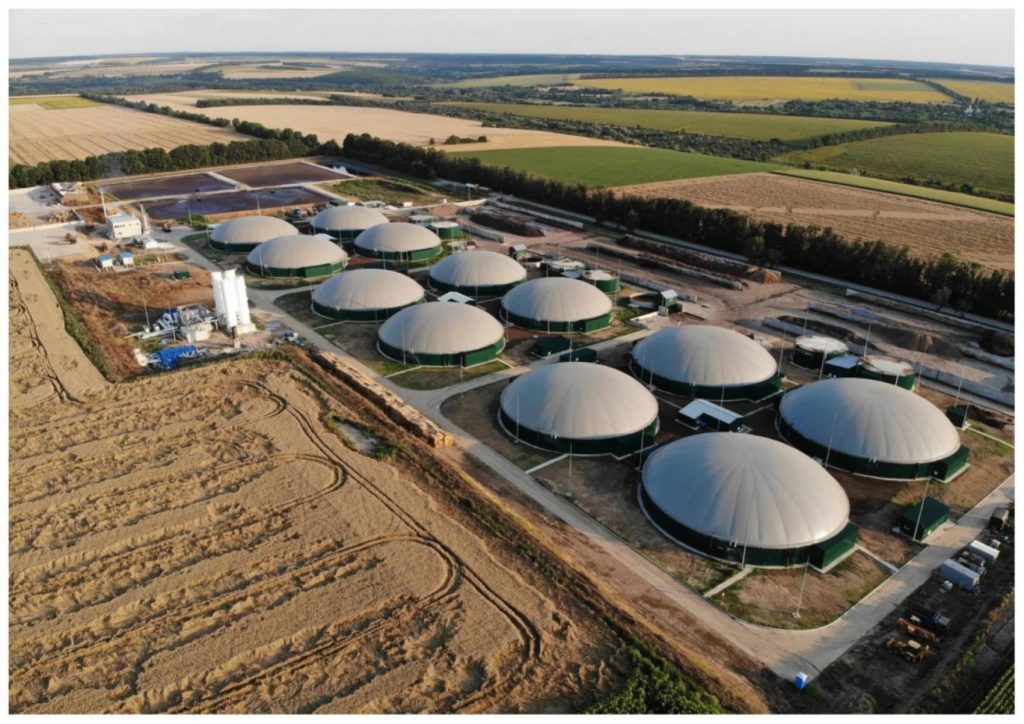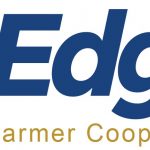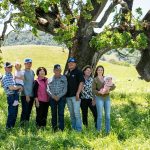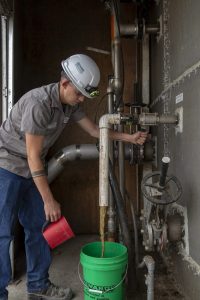
By Lena Beck for Modern Farmer.Broadcast version by Mike Moen for Wisconsin News Connection reporting for the Modern Farmer-Public News Service Collaboration.
At the end of February, the town board of Lind, Wisconsin voted against changing the zoning laws to allow a nearby 600-cow dairy to install an anaerobic digester. These digesters are becoming more common, particularly at larger dairy operations housing thousands of cows, called concentrated animal feeding operations (CAFOs). This is partially because they have been included as a key ingredient in the Biden administration’s pledge to reduce methane emissions in animal agriculture.
At CAFOs, it is common to pool animal waste in one spot, called a manure lagoon. Anaerobic digestion creates a mixture of gases, which can be used for electricity or further processed into fuel for vehicles. The idea is to take advantage of these large quantities of waste to create something useful and reduce methane emissions, helping the climate along the way.
However, that’s not quite how it works out. In Lind, an overwhelming number of citizens showed up for a public hearing to discuss the change—the Wisconsin Examiner reported that there were so many attendees, they exceeded the capacity of the building and the meeting had to be canceled. Community organizers, under the group name Citizens Protecting Rural Wisconsin, argued that digesters aren’t the solution that they seem to be.
A new report by Friends of the Earth US and Socially Responsible Agriculture Project (SRAP) backs up that sentiment. The study suggests that methane digesters create incentives for the growth of industrial agriculture, further entrenching food systems that harm both people and the environment. These researchers, communities and advocates are working hard to resist the greenwashing of this technology—and sometimes they succeed. Vanguard Renewables, the company partnering with the dairy near Lind, officially withdrew its application to build in March.
The report
Anaerobic digesters are not typically things that you would ever see on a small, pasture-based dairy or farm. Digesters require a lot of manure to work, meaning that they are more poised to be installed on CAFOs that typically have hundreds or thousands of animals. This suggests that supporting biogas production incentivizes the growth of the CAFO industry.
“If we put money towards biogas, we’re essentially helping to subsidize and further entrench industrial livestock production,” says Chris Hunt, deputy director at SRAP and a contributor to this report, “and essentially the worst possible ways of managing waste, which is manure lagoons.”
This growth was documented in the report, finding that herd size at the studied CAFOs with digesters grew 3.7 percent year over year—24 times the growth rate of typical dairies in the states they studied.
“Once you have a digester in place, there’s an incentive to create more biogas, because there’s now a market for biogas,” says Hunt. “The only way of doing that is to create more waste. So, there’s an incentive to add more animals to herd size.”
Greenwashing
The Global Methane Pledge was launched at COP26, aiming to reduce global methane emissions by 30 percent by 2030, using 2020 levels as a baseline. In 2021, the US released its own methane reduction plan. Expanding manure biogas production was listed as a key way to reduce methane emissions in the agriculture sector. Between 2010 and 2020, the USDA Rural Business Cooperative Service supported grants and loans totaling $117 million toward anaerobic digesters.
This plan aims to develop the industry further. Not only does it commit the USDA to launch additional work into biogas policies and research, but existing Farm Bill conservation programs such as the Conservation Stewardship Program (CSP) and the Environmental Quality Incentives Program (EQIP) will provide resources in service of manure biogas production.
In 2020, manure accounted for about 9 percent of the US’s methane emissions. The greater source of methane from animal agriculture is through enteric fermentation—created through the process of digestion. This accounted for about 27 percent of US methane emissions. Using anaerobic digesters to produce biogas can only address that 9 percent, and it does nothing to reduce the 27 percent inherent to ruminant agriculture—animals such as cows, buffalo, goats and sheep.
The gases produced by anaerobic digestion are being used for electricity and to power vehicles, but as the report and other advocacy organizations argue, this doesn’t make it a clean fuel.
“When you burn this fuel as an end use, it’s essentially the same as burning fossil fuels,” said Kat Ruane of Food & Water Watch during a recent webinar about biogas production in California. “It produces similar pollutants, it harms the environment in the same way and you’re still pumping gas into the atmosphere that we really don’t need to be there. So, clearly, this cannot be a solution to climate change.”
Food & Water Watch did its own study on digesters in California feeding into the state’s Low Carbon Fuel Standard (LCFS) program. The leakage rates of these digesters could be as much as 15 percent. Food & Water Watch used satellite images of methane plumes overlaid with geographic information about where digesters in the LCFS program were located. They documented 16 dairy operations that emitted plumes, producing 59 plumes between March 2017 and July 2023. The emission rates of these plumes reached as high as 1,729 kilograms of methane per hour. A “super-emitter” in the imaging system is classified as just 10 kilograms of methane per hour.
“Another huge greenwashing problem with this technology is just the fact that it does not work,” said Ruane. “[It’s] an absolutely mind-boggling amount of pollution being produced under the guise of supposedly helping the climate.”
In addition to research, Food & Water Watch mobilizes people on issues related to food systems and factory farming. On its website, you can read about its various objectives and wins against industrialized farming as well as calls to action on these issues. Hunt of SRAP also encourages people directly dealing with the impact of factory farming on their community to reach out directly.
“If any of your readers are facing a factory farm, they should contact us,” says Hunt. “We provide free support to communities throughout the US to help them protect themselves from the damaging impacts of industrial livestock operations.”
There’s no uniform approach for dealing with this issue, he says, as it depends a lot on regional factors, but SRAP provides resources such as the SRAP Help Hotline and SRAP Water Rangers Program, which offers free training on how to collect and analyze water samples, document pollution and report violations.
“There’s not really one universal secret. But this is what our organization does. So, I would encourage folks to reach out to us for help.”
Digesters don’t erase factory farm concerns
Even if biogas production wiped out methane emissions completely, that’s still a narrow view of the factory farm problem, says Hunt.
“Biogas doesn’t solve the factory farm issue,” says Hunt. “Greenhouse gas emissions aren’t the only problems in factory farms. As someone who’s been working on this issue for 20 years, it’s actually one of the problems with factory farms that concerns me the least.”
He says that methane emissions are being misconstrued as the major problem caused by factory farms, and biogas has been used as the proxy for fixing all the problems explicitly with CAFOs. “But they don’t do that at all,” says Hunt.
Digesters don’t address worker or animal rights abuses at CAFOs, nor all of the environmental concerns. Moreover, many of the human health impacts are not mitigated by anaerobic digesters.
“When you have too many animals in one place, you’re going to have too much waste in one place, and that waste becomes a problem—that waste becomes a pollutant,” says Hunt. “So, these facilities pollute the air, pollute the water and threaten public health and spoil people’s drinking water. Adding digesters doesn’t actually fix that.”
As of 2020, there were more than 21,000 CAFOs in the US, and some are clustered geographically. In California’s San Joaquin Valley, for example, some people live next to as many as 25 CAFOs.
The abundance of CAFOs in the San Joaquin Valley isn’t accidental, says Leslie Martinez, community engagement specialist at the Leadership Counsel for Justice and Accountability (LCJA). The San Joaquin Valley has several historically Black communities that are now largely Latino, and the abundance of polluters is evidence of environmental racism—hazardous materials or operations being located or dumped in communities of color. Moreover, many of these communities are unincorporated, and this can make it more difficult for residents to advocate for themselves.
“First and foremost, I think it’s really important that people understand the health impacts that come with so many large animals being confined in one area,” says Martinez.
These impacts include sleep apnea, asthma and other respiratory issues, as well as not being able to go outside because of the intensity of the smell or due to being swarmed by flies. CAFOs present a threat of nitrate pollution, which can cause a variety of illnesses including blue baby syndrome. Manure contamination can also lead to severe pathogen-related illnesses such as listeriosis and tetanus. The SRAP and Friends of the Earth report posits that while anaerobic digesters achieve temperatures that can kill some pathogens, the real solution is not to have such high concentrations of animals in the first place.
Martinez, who was born and raised in Tulare County in the San Joaquin Valley, works closely with other local organizers to do policy work against the LCFS rewarding CAFOs, such as trying to eliminate methane crediting. She encourages everyone to speak up on the impacts of dairies.
“Attend a workshop, speak up and be like, ‘As somebody who lives next to a dairy, as someone who lives next to a dairy with a digester, this is my reality of what I live with,’” says Martinez. “No one should be able to take away your right to clean air and clean drinking water and get away with it.”
On the LCJA website, you can read more about this work and find information for taking action. Small dairy farmers who’ve had success should share their stories, too, she says.
“Small farmers, rise up,” says Martinez. “There are success stories that I think need to be talked about. And I would love to hear what their solutions are to this epidemic of the CAFO industry.”
A more sustainable future for dairy
As the SRAP and Friends of the Earth report states, “Only if one accepts the status quo model for industrial animal production as the baseline can it be argued that manure biogas has any benefits.” For Hunt, biogas production is not compatible with climate change solutions at all.
“I don’t think a sustainable future is compatible with the CAFO model,” he says. “You can spend millions of dollars and stick a digester on top of your lagoon, you can stunt the emissions a little bit that way. But you’re still left with all these other problems that are inherent in that model.”
Martinez encourages those who consume milk and dairy products to think critically about how these products get to your table. Collectively, she says, we need to think about what sustainability is and what we as consumers are willing to accept.
“Right now, people are saying that you having access to [these products] is more important than a young child being able to go outside and ride their bike or walk home from school,” says Martinez. “Because right now that’s kind of what the trade-off is.”
In her organizing, Martinez has been accused of being anti-dairy industry and anti-dairy farmer.
“But that is not true. I think that there is a place for dairies. And I think that that place for dairies is when you don’t have thousands of cows. It’s not sustainable,” she said in the Food & Water Watch webinar. “If we want to genuinely keep dairies around in California or in Wisconsin, wherever, they have to be truly sustainable. And that means making big changes.”
Lena Beck wrote this article for Modern Farmer.
You can now read the most important #news on #eDairyNews #Whatsapp channels!!!
🇺🇸 eDairy News INGLÊS: https://whatsapp.com/channel/0029VaKsjzGDTkJyIN6hcP1K



















